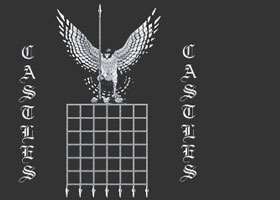The Medieval LongbowThe Medieval Longbow - The History of the Medieval Longbow
- Description of the English Longbow
- Training to use the Longbow in the Butts
- The V-Sign two-fingered salute adopted by Longbow Archers
- English Lonbow - A decisive weapon
Description of the Medieval Longbow
Every Medieval Longbow was made to measure. The length of the longbow therefore ranged considerably in size from 6 - 7 feet in length. Most longbows were made from yew but ash, hazel and elm were also used. The bow stave was shaped into a D-section from a half cross section of a tree or branch. The wood of the bow was protected with a rub of "wax, resin, and fine tallow". A skilled longbow man could release between 10 - 12 arrows per minute. The longbow could also pierce armour at ranges of more than 250 yards. The string of the longbow was made from hemp as it was the strongest and least elastic fibre available. The string was then soaked in glue as some protection against moisture. The longbow arrow was a straight shaft with a sharp point on one end and measuring about 3 feet long. Long Bodkin point arrows were used with the longbow for piercing mail. Short bodkins were used for piercing armor plate. Arrows called swallowtails were used to bring down horses Training to use the Medieval Longbow
Skill in using the Medieval longbow had to be acquired over many years. The Archery Law ensured that Englishmen would practise with the longbow every week on a Sunday. Special places were assigned for the longbow archery training (prior to this there were many accidents when people were hit by 'loose' arrows). These designated longbow training areas were called 'Butts'. The word Butt is derived from the Anglo French word 'bouter' meaning to expel. The word 'Butts' is now obsolete but still lives on in English place names such as Newington Butts in South London. A target was used and it was necessary for longbow archers to become proficient in both speed and accuracy when releasing arrows. Archery practise would start for young boys from the age of seven years. The Medieval Longbow and the Two-Fingered Salute - the English V-Sign!
The two-fingered salute - the V-Sign - is still used today when the index and middle finger is held aloft as an obscene gesture of total disdain and derision! This salute dates back to the English Longbowman who fought the French during the Hundred Years War (1337 - 1453). The French hated the English archers who used the Longbow with such devastating effect. Any English archers who were caught by the French had their Index and middle fingers chopped off from their right hand- a terrible penalty for an archer. This led to the practice of the English archers, especially in siege situations, taunting their French enemy with their continued presence by raising their two fingers in the 'Two-Fingered Salute' meaning "You haven't cut off my fingers !" The Decline of the Longbow
The musket was invented towards the end of the Medieval era in 1520. By 1595 all bows were ordered to be exchanged for muskets. However the longbows were still very much in force in 1545 when the warship Mary Rose ( the flagship of King Henry VIII ) was sunk. The Mary Rose was raised in 1982 and, unexpectedly, 250 longbows and 8000 arrows were found on board! | 
